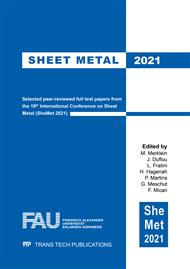p.89
p.97
p.105
p.111
p.119
p.127
p.135
p.143
p.151
New Joining Concepts for Self-Pierce Riveting
Abstract:
This paper is focused on innovative self-pierce riveting concepts to produce invisible joints in sheet-sheet and tube-sheet connections. The common element to these two different types of joints is the use of tubular rivets with chamfered ends, which are accessories in the case of sheet-sheet joints and constitutive (structural) elements in the case of tube-sheet joints. The presentation draws from the deformation mechanics of double-sided self-pierce riveting for producing lap joints in overlapped sheets to the development of self-pierce riveting of tubes to sheets, which is a new joining by forming process capable of attaching a sheet to the end of a tube, at room temperature. Aluminum sheets, carbon and stainless-steel tubes are utilized to demonstrate the effectiveness of the new self-pierce riveting concepts and finite element modelling using an in-house computer program gives support to the overall presentation. Destructive tests are carried out to evaluate the destructive strength that the joints are capable to withstand without failure.
Info:
Periodical:
Pages:
119-126
Citation:
Online since:
April 2021
Authors:
Keywords:
Price:
Сopyright:
© 2021 Trans Tech Publications Ltd. All Rights Reserved
Share:
Citation:


